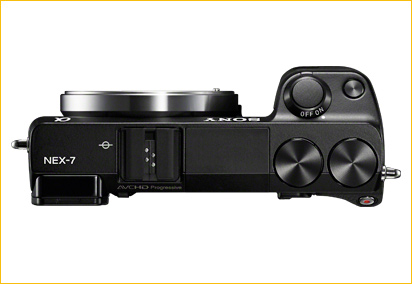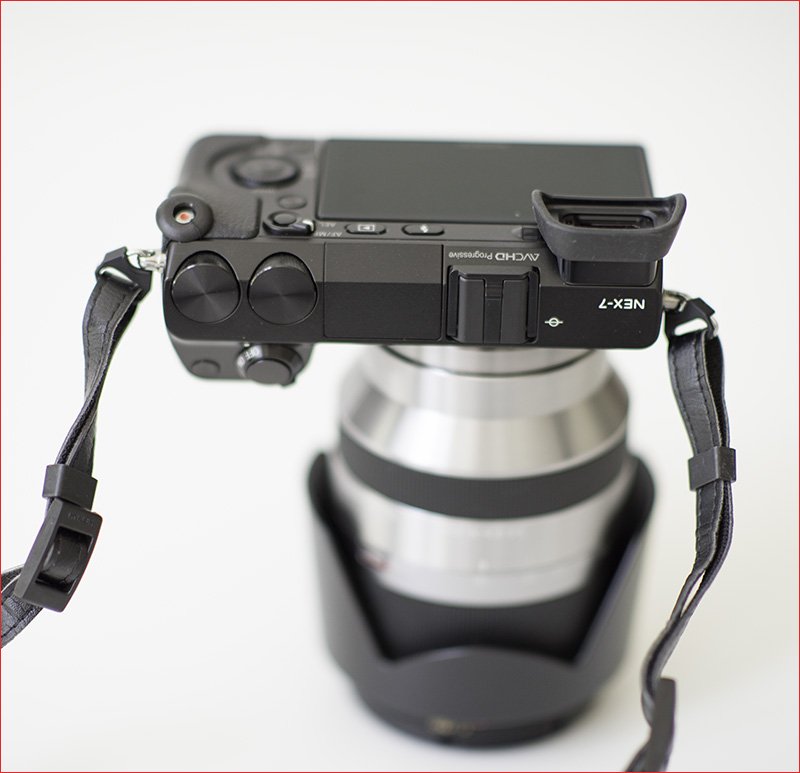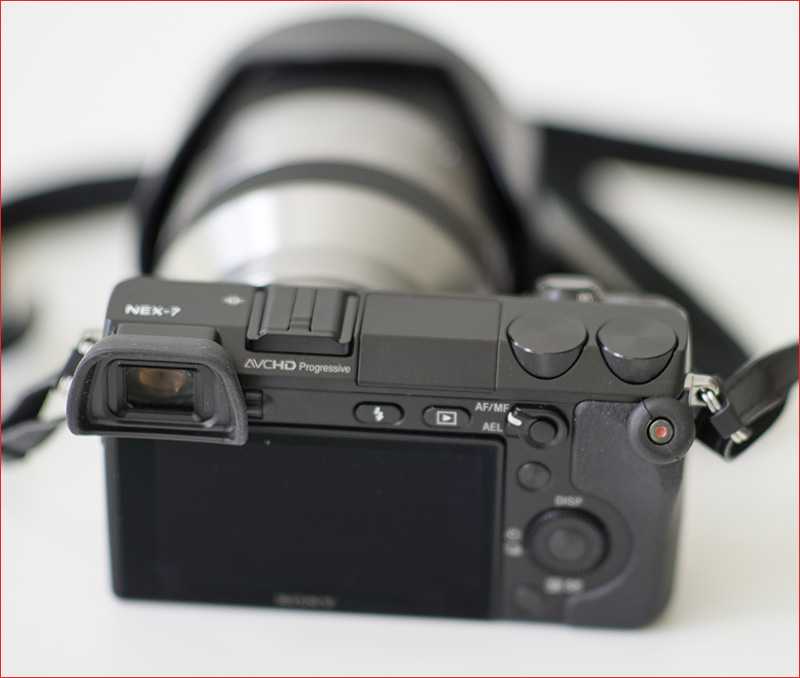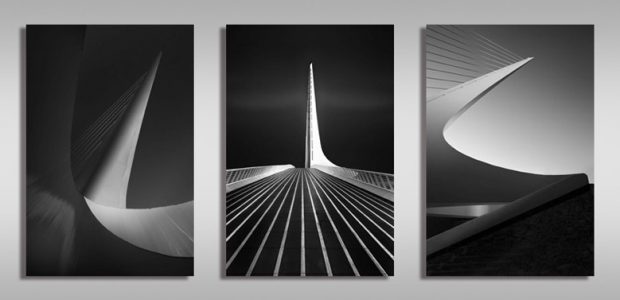
The Big Problem with the NEX 7
As reported repeatedly on this site and on many others, Sony made a giant blunder with the location of the video button on the NEX 7. It is in a place on the grip where it constantly gets inadvertently pushed by simply grasping the camera. To make matters worse, there is no way to disable or lock this button. You push it and the camera immediately starts shooting video.
In early May, 2012, during the workshop and exhibit that Michael Reichmann and I did in Toronto, the owner of44 Wide(where the printing workshop and exhibit took place) purchased a new NEX 7. I alerted him to the video button issue and he scoffed telling me he would be careful and it would not affect him. Two days later, he confessed that he had never taken so much video of a lens cap in his entire life, and he was really getting annoyed by the issue.
I have shot many hours of video of the inside of my bag, the lens cap, my shoes, etc. The problem is annoying enough due to the waste of batteries and memory, but the real issue that makes it worse for me is that I have missed a number of really good, perhaps once in a lifetime shots because when I bring the camera up to my eye and press the shutter release nothing happens. The reason is that the camera is in the middle of shooting video and it will obviously not shoot stills while in this mode.
In my view, this situation is unacceptable.
The Sony Response
Although just about every review of the camera complains about the video button, and each and every user I have spoken to complains about this issue, after more than 9 months of the problem being widely published, the Sony reaction has been silence. Nothing.
I experienced this issue on my first day of working with the NEX-7 at thepress launch in August 2011and reported it immediately to senior Sony representatives. That this was a known issue from the product launch until today does not, as Mark says, speak well for Sony’s responsiveness to a serious design flaw. – Michael
As a NEX 7 user, I find this unacceptable and quite sad. Unacceptable because when I spend my hard earned dollars on a product and the product has an obvious flaw that can probably be easily fixed by a simple firmware update, I feel that the company owes it to their customers to provide a fix as soon as possible.
Quite sad… because I was recently reading that Sony reported yet another year of huge losses and one must wonder how a company with such great technology, brilliant engineers and huge resources seems to have lost its way. It has given up huge markets to others and in spite of brilliant engineering it has failed to properly test its products and to satisfy or respond to customers the way it should. Unfortunately, the NEX 7 is yet another example of a camera that should have been an A+, but has several substantial flaws that Sony could and should fix but for some unexplainable reason refuses to do so.
Let us hope that they do something to regain their mojo, otherwise it will be very sad to see them go the way Kodak went….
What to do?
I finally got fed up waiting for Sony and decided to take matters into my own hands.
Rednecks
Those living in the United States and Canada are very familiar with Rednecks, so they can avoid the following explanation. However, we have many readers outside these two countries who may want to know what the term “Redneck” means:
The popular etymology says that the term derives from such individuals having a red neck caused by working outdoors in the sunlight over the course of their lifetime. The effect of decades of direct sunlight on the exposed skin of the back of the neck not only reddens fair skin, but renders it leathery and tough, and typically very wrinkled by late middle age. Another popular theory for the origin of the name stems from the use of red bandannas tied around the neck to signify union affiliation during the violent clashes between United Mine Workers and the owners of the mines between 1910 and 1920.
Some historians claim that the term redneck originated in 17th century Virginia, when indentured servants were sunburnt while tending plantation crops.
A redneck is usually typified in current popular culture as a straight male with a beer belly that consumes cheap American beer by the case. They are generally distrustful or dislike anyone not like them. The stereotypical redneck lives in a trailer, and drives an old, large, beat-up pickup truck. He generally wears a stained, sleeveless t-shirt, blue jeans, and a trucker hat. His favorite activities include hunting, shooting at road signs and lights, professional wrestling, NASCAR, monster truck rallies, car engine repair, and collecting junked cars and large appliances on his front lawn. Rednecks are known for having way too many children and dogs, participating in domestic disturbances, and waiting around for their welfare checks.
They are famous for performing repairs to electric systems, plumbing or defective machines by using simple objects that can be found in a junk yard or a small town hardware store. This has given rise to many jokes in the United States, as the repairs can be flimsy and look comical, although sometimes they do work.
The NEX 7 Redneck Edition
So without further ado, I present to you theSony Nex 7 Redneck Edition:

Sony NEX 7 Redneck Edition
Sharp readers will immediately notice the rubber grommet mounted around the video button (the one with the red dot).
Here is a different view of the NEX 7 Redneck Edition:

Another view of the Sony NEX 7 Redneck Edition
How does it work?
The solution was for me to go to the hardware store and purchase a gromet with a hole slightly larger than the diameter of the video button. Most grommets happen to be too thick, but they are easily cut in half (like a bagel) with a sharp X-Acto knife. This reduces the thickness and provides one flat side.
After cutting the grommet as described, I used a small amount of super glue on the flat side (Gorillabrand super glue specially formulated for rubber leather, etc. works extremely well) and glued it to the camera.
Now, neither my fingers nor my hand can push the video button. However, if l want to shoot video I can still push the video button through the center hole with a pen, pencil, toothpick or other skinny object. Since I rarely shoot video with the NEX 7, this solution works great for me.
Conclusion
I hope this “Redneck fix” will be helpful to those who use the camera mostly for still images and are desperate to get rid of this problem. I also hope that everyone who has experienced the problem will let Sony know. Even though I am not optimistic, one never knows, and the more we complain the better our chances of getting Sony to finally do something.
Sadly, I expect this to be about as likely as Canon adding a proper mirror lockup button to their DSLRs. – Michael
If anyone has an alternate solution, I would encourage you to share it in ourdiscussion forum.
Mark Dubovoy
May, 2012
One More Thing
There is one other aspect to this issue that was also apparent since day one, and has been known to cause cardiac arrest among NEX-7 owners. This problem is that the NEX-7 inexplicably maintains two separate directory structures for its video and stills files. So, when you first discover that you have shot 20 minutes of the inside of your camera bag, and you delete the offending video to clear room on the card, the camera displays – DELETING IMAGE S . Note the plural!? Even if you are just deleting one video file, or one still image, it says IMAGE S . Heart attack number one.
Heart attack number two is that after you delete the offending video file and then press PLAY the screen displays NO IMAGES, even if you have shot hundreds of raws or JPGs on the same card. The reason for this is that there are separate directories for the two types of files. The simple solution is to shoot a quick still, and now the stills directory of files becomes available. There is also a convoluted way through the menus, but life is too short to delve into Sony menu land unless one really has to.
Sony – you’ve known about these issues since August, 2011. Isn’t it time that these to were corrected?
– Michael Reichmann
You May Also Enjoy...
Seeing Lines – Part 1: Pre-Visualizing
After leaving Civil Engineering to become a photographer, I naturally gravitated towards the subject matter of architectural photography, namely bridges. I guess I was intrinsically
Waiting for The Next Model
A day doesn't go by when I'm asked, "Should I buy theWhatsitFlex,or should I wait until the next model comes out?" One sees this on

